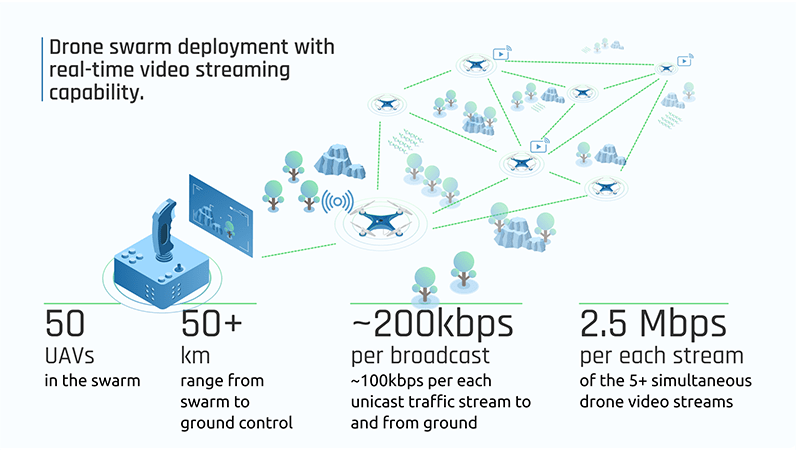UAV swarm connectivity elevation: deploying a 50-drone swarm

Meshmerize embarked on an ambitious project to connect a drone swarm consisting of 50 drones. The project’s core objective was to establish a highly sophisticated UAV (Unmanned Aerial Vehicle) network capable of performing complex formations and maneuvers in the air, as well as streaming a live video, all while being controlled from a ground station located 50 kilometers away.
- Establish a robust communication link between the drone swarm and the ground control station over a distance of 50 kilometers.
- Implement a high-frequency mesh network among the drones to continuously broadcast their 3D geolocations, maintaining a safe distance.
- Enable multiple video streams from specific drones back to the ground station.
- Integrate special drones equipped with long-distance radios to facilitate reliable long-range communication with the ground station.
- Prioritize critical command data over video feeds.
range from swarm to ground control
drones in the swarm
per each broadcast and ~100kbps per each unicast traffic stream to and from ground
per each of the 5+ simultaneous drone video streams
At the heart of the drone swarm’s operational capabilities lies a sophisticated mesh network, designed to facilitate seamless communication among the drones. This network serves a dual purpose.
Firstly, it enables the drones to relay command messages received from the ground control, ensuring that each unit within the swarm executes its part in the tasks flawlessly.
Secondly, and crucially, it supports the broadcast of safety messages at a high frequency. Each drone continuously shares its 3D location within the swarm, creating a dynamic ‘no-fly zone’ around itself to prevent collisions. This constant exchange of positional data is vital for maintaining the integrity of the swarm and ensuring the safety of each drone within the network.

Long-Distance UAV Connectivity

To connect the swarm with the ground control station located 50 kilometers away, 6 specialized drones carrying long-range radios are incorporated into the swarm. These drones act as communication nodes, relaying information between the ground control and the swarm.
This setup ensures that command and control messages are effectively communicated over long distances, maintaining the operational link between the swarm and its human operators. Using these specialized drones demonstrates a clever approach to overcoming the challenge of long-distance communication in UAV operations.
Each drone continuously broadcasts its 3D location to maintain a safety bubble, preventing collisions by announcing its position five times per second. The continuous flow of location data might overload a mesh network, leading to a situation where multiple drones redundantly circulate the same message, creating an “echo chamber” effect.
Meshmerize addresses this challenge with sophisticated echo detection techniques, similar to how bats use echolocation. With around 50 nodes each broadcasting at ~200kbps, Meshmerize intelligently minimizes unnecessary rebroadcasts, Meshmerize ensures that these critical location broadcasts are efficiently disseminated across the swarm, maintaining clear and effective communication without overloading the network.


Within the Meshmerize-enabled drone swarm, traffic prioritization is essential to maintaining operational efficiency and safety.
Command messages to and from drones have the highest priority, reflecting their critical role in controlling the swarm.
Broadcast traffic has lower priority because it is less critical than direct command messages.
While they are crucial for successful task completion, video streams are assigned an even lower priority to ensure that vital control commands are always delivered promptly.
The drone swarm is equipped with cameras, enabling the relay of multiple video feeds to the ground station. Operators can selectively choose feeds from any of the drones, with the capability to view simultaneous streams from five or more drones at any given time, each up to 2.5 Mbps. This flexibility allows for a control room setup where the most relevant video feeds can be monitored in real time, enhancing mission control’s situational awareness and decision-making capabilities.
Despite the lower priority assigned to video traffic compared to direct command and control messages, Meshmerize’s network ensures these video streams are efficiently managed and delivered without compromising the swarm’s operational integrity.


An important component in the operational success of the drone swarm is the hardware utilized onboard each drone.
Acksys EmbedAir, the chosen hardware, provides robust and reliable communication capabilities vital for both the mesh network within the swarm and the mesh network on the ground. The two meshes are connected by separate wireless radio devices providing the long-distance connectivity from air to the ground.
- Meshmerize successfully connected 50 drones, demonstrating advanced aerial formations and maneuvers controlled from a ground station 50 kilometers away.
- A sophisticated mesh network enables precise coordination and collision avoidance by broadcasting real-time 3D locations.
- Specialized drones equipped with long-range radios facilitate effective long-distance connectivity between the swarm and ground control.
- The system’s capability to stream video from five or more drones simultaneously enhances operational visibility.
- Critical command data is prioritized over broadcast and video feeds within the network.






